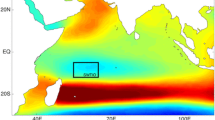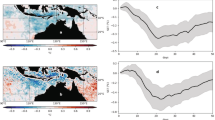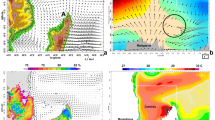Abstract
The unique geography of the Mozambique Channel largely results from the mountainous island of Madagascar, the fourth largest island in the world by area, extending 13 degrees of latitude. Madagascar, which forms the eastern boundary of the Mozambique Channel, is the only example worldwide of a large tropical island situated just offshore from a tropical-subtropical continent. The Channel has important consequences for southeastern African climate, oceanic circulation and is also a region of high biodiversity. Here, the annual cycle of the regional ocean–atmosphere interactions and circulation are synthesized to help explain some of the distinctive features of southeastern African climate, including the Mozambique Channel Trough, tropical cyclone and mesoscale convective system activity, and rainfall distributions. Upper ocean heat transport from the north into the Channel is greater than that south out of the Channel throughout the year, but particularly in March–April, so this region acts as a warm pool helping to fuel convective activity. From November to April, both Madagascar and Mozambique experience substantial shifts in the areas of maximum contribution to average rainfall from tropical cyclones. Over Mozambique, this average is impacted by the impact of relatively few very intense systems either making landfall or tracking close by in the Channel. However, on average, large areas of Mozambique receive ~ 10–30% of their summer rainfall from these systems whereas for Madagascar, the contribution is much higher (~ 30–70%). The greater frequency of intense tropical cyclones in March–April relative to the mid-summer appears related to the tropical cyclone heat potential reaching its maximum during these months.











Similar content being viewed by others
Data availability
All data used in this study are publicly available. ERA5 data are available from the ECMWF data server (https://cds.climate.copernicus.eu/cdsapp#!/dataset/reanalysis-era5-single-levels?tab=form). Rainfall data are available from Climate Hazards Group InfraRed Precipitation with Station Data (CHIRPS; https://www.chc.ucsb.edu/data/chirps). Tropical cyclone data are available from the International Best Track Archive for Climate Stewardship (IBTrACS) data set (https://www.ncei.noaa.gov/data/international-best-trackarchive-for-climate-stewardship-ibtracs/v04r00/access/netcdf/). Surface and subsurface ocean variables are available from NOAA's Optimum Interpolation Sea Surface temperature (OISST), Archiving Validation and Interpretation of Satellite Data in Oceanography (AVISO) with support from CNES (https://resources.marine.copernicus.eu/productdetail/SEALEVEL_GLO_PHY_L4_REP_OBSERVATIONS_008_047/INFORMATION) and GLORYS12V1 product (https://resources.marine.copernicus.eu/?option=com_csw&view=order&record_id=c0635fc4-07d3-4309-9d55-cfd3e6aa788b) respectively.
References
Huang X (2017) A comprehensive Mesoscale Convective System (MSC) dataset, links to files in MatLab and plain text format. Tsinghua University, Beijing, PANGAEA. https://doi.pangaea.de/10.1594/PANGAEA.877914 Accessed 12 October 2019.
Backeberg BC, Reason CJC (2010) A connection between the South Equatorial Current north of Madagascar and Mozambique Channel eddies. Geophys Res Lett 37(4):L04604. https://doi.org/10.1029/2009GL041950
Balaguru K, Chang P, Saravanan R, Leung LR, Xu Z, Li M, Hsieh JS (2012) Ocean barrier layers’ effect on tropical cyclone intensification. Proc Natl Acad Sci USA 109(36):14343–14347. https://doi.org/10.1073/pnas.1201364109
Barimalala R, Desbiolles F, Blamey RC, Reason CJC (2018) Madagascar influence on the south Indian Ocean convergence zone, the Mozambique channel trough and southern African rainfall. Geophys Res Lett 45(11):380–389. https://doi.org/10.1029/2018GL079964
Barimalala R, Blamey RC, Desbiolles F, Reason CJC (2020) Variability in the Mozambique Channel Trough and impacts on southeast African rainfall. J Clim 33(2):749–765. https://doi.org/10.1175/JCLI-D-19-0267.1
Barimalala R, Blamey RC, Desbiolles F, Reason CJC (2021) The influence of southeastern African river valley jets on regional rainfall. Clim Dyn 57(9):2905–2920. https://doi.org/10.1007/s00382-021-05846-1
Behera SK, Yamagata T (2001) Subtropical SST dipole events in the southern Indian Ocean. Geophys Res Lett 28(2):327–330. https://doi.org/10.1029/2000GL011451
Biastoch A, Krauss W (1999) The role of mesoscale eddies in the source regions of the Agulhas Current. J Geophys Res Oceans 29(9):2303–2317. https://doi.org/10.1175/1520-0485(1999)029%3c2303:TROMEI%3e2.0.CO;2
Biastoch A, Reason CJC, Lutjeharms JRE, Boebel O (1999) The importance of flow in the Mozambique Channel to seasonality in the greater Agulhas Current system. Geophys Res Lett 26(21):3321–3324. https://doi.org/10.1029/1999GL002349
Blamey RC, Reason CJC (2012) Mesoscale convective complexes over southern Africa. J Clim 25(2):753–766. https://doi.org/10.1175/JCLI-D-10-05013.1
Blamey RC, Reason CJC (2013) The role of mesoscale convective complexes in southern Africa summer rainfall. J Clim 26(5):1654–1668. https://doi.org/10.1175/JCLI-D-12-00239.1
Blamey RC, Middleton C, Lennard C, Reason CJC (2017) A climatology of potential severe convective environments across South Africa. Clim Dyn 49(5):2161–2178. https://doi.org/10.1007/s00382-016-3434-7
Blamey RC, Kolusu SR, Mahlalela P, Todd MC, Reason CJC (2018) The role of regional circulation features in regulating El Nino climate impacts over southern Africa: a comparison of the 2015/2016 drought with previous events. Int J Climatol 38(11):4276–4295. https://doi.org/10.1002/joc.5668
Collins C, Reason CJC, Hermes JC (2012) Scatterometer and reanalysis wind products over the western tropical Indian Ocean. J Geophys Res Oceans 117:C03045. https://doi.org/10.1029/2011JC007531
Collins C, Hermes JC, Reason CJC (2014) Mesoscale activity in the Comoros basin from satellite altimetry and a high-resolution ocean circulation model. J Geophys Res Oceans 119(8):4745–4760. https://doi.org/10.1002/2014JC010008
Collins C, Hermes JC, Roman RE, Reason CJC (2016) First dedicated hydrographic survey of the Comoros Basin. J Geophys Res Oceans 121(2):1291–1305. https://doi.org/10.1002/2015JC011418
Cook C, Reason CJC, Hewitson BC (2004) Wet and dry spells within particularly wet and dry summers in the South African summer rainfall region. Clim Res 26(1):17–31. https://doi.org/10.3354/cr026017
d’Abreton PC, Lindesay JA (1993) Water vapour transport over southern Africa during wet and dry early and late summer months. Int J Climatol 13(2):151–170. https://doi.org/10.1002/joc.3370130203
de Boyer MC, Madec G, Fischer AS, Lazar A, Iudicone D (2004) Mixed layer depth over the global ocean: an examination of profile data and a profile-based climatology. J Geophys Res 109:C12003. https://doi.org/10.1029/2004JC002378
de Ruijter WP, Ridderinkhof H, Lutjeharms JR, Schouten MW, Veth C (2002) Observations of the flow in the Mozambique Channel. Geophys Res Lett 29(10):140–141. https://doi.org/10.1029/2001GL013714
de Ruijter WP, van Aken HM, Beier EJ, Lutjeharms JR, Matano RP, Schouten MW (2004) Eddies and dipoles around South Madagascar: formation, pathways and large-scale impact. Deep Sea Res I: Oceanogr Res Pap 51(3):383–400. https://doi.org/10.1016/j.dsr.2003.10.011
Dyson LL, Van Heerden J, Sumner PD (2015) A baseline climatology of sounding-derived parameters associated with heavy rainfall over Gauteng. South Afr Int J Climatol 35(1):114–127. https://doi.org/10.1002/joc.3967
Emanuel K, DesAutels C, Holloway C, Korty R (2004) Environmental control of tropical cyclone intensity. J Atmos Sci 61(7):843–858. https://doi.org/10.1175/1520-0469(2004)061%3c0843:ECOTCI%3e2.0.CO;2
Funk CC, Peterson PJ, Landsfeld MF, Pedreros DH, Verdin JP, Rowland JD, Romero BE, Husak GJ, Michaelsen JC, Verdin AP (2014) A quasi-global precipitation time series for drought monitoring. US Geol Surv Data Ser 832(4):1–12. https://doi.org/10.3133/ds832
Ganachaud A, Wunsch C, Marotzke J, Toole J (2000) Meridional overturning and large-scale circulation of the Indian Ocean. J Geophys Res 105(C11):26117–26134. https://doi.org/10.1029/2000JC900122
Goni GJ, Trinanes JA (2003) Ocean thermal structure monitoring could aid in the intensity forecast of tropical cyclones. Eos Trans AGU 84(51):573–578. https://doi.org/10.1029/2003EO510001
Halo I, Backeberg B, Penven P, Ansorge I, Reason CJC, Ullgren JE (2014) Eddy properties in the Mozambique Channel: a comparison between observations and two numerical ocean circulation models. Deep Sea Res II: Top Stud Oceanogr 100:38–53. https://doi.org/10.1016/j.dsr2.2013.10.015
Han G, Dong C, Li J, Yang J, Wang Q, Liu Y, Sommeria J (2019) SST anomalies in the Mozambique Channel using remote sensing and numerical modeling data. Remote Sens 11(9):1112. https://doi.org/10.3390/rs11091112
Hart NCG, Reason CJC, Fauchereau N (2010) Tropical–extratropical interactions over southern Africa: three cases of heavy summer season rainfall. Mon Weather Rev 138(7):2608–2623. https://doi.org/10.1175/2010MWR3070.1
Hart NC, Reason CJC, Fauchereau N (2013) Cloud bands over southern Africa: seasonality, contribution to rainfall variability and modulation by the MJO. Clim Dyn 41(5):1199–1212. https://doi.org/10.1007/s00382-012-1589-4
Howard E, Washington R, Hodges KI (2019) Tropical lows in southern Africa: tracks, rainfall contributions, and the role of ENSO. J Geophys Res Atmos 124(21):11009–11032. https://doi.org/10.1029/2019JD030803
Huang X, Hu C, Huang X, Chu Y, Tseng YH, Zhang GJ, Lin Y (2018) A long-term tropical mesoscale convective systems dataset based on a novel objective automatic tracking algorithm. Clim Dyn 51(7):3145–3159. https://doi.org/10.1007/s00382-018-4071-0
IPCC, Stocker TF, Qin D, Plattner G.-K, Tignor M, Allen SK, Boschung J, Nauels A, Xia Y, Bex V, Midgley PM (2013) Climate change 2013: the physical science basis. contribution of working group I to the fifth assessment report of the intergovernmental panel on climate change. IPCC, Berlin, p 1535
IPCC, Masson-Delmotte V, Zhai P, Pirani A, Connors SL, Péan C, Berger S, Caud N, Chen Y, Goldfarb L, Gomis MI, Huang M, Leitzell K, Lonnoy E, Matthews JBR, Maycock TK, Waterfield T, Yelekçi O, Yu R, Zhou B (2021) Climate Change 2021: the physical science basis. In: Contribution of Working Group I to the Sixth Assessment Report of the Intergovernmental Panel on Climate Change. Cambridge University Press. (In Press)
Klinman MG, Reason CJC (2008) On the peculiar storm track of TC Favio during the 2006–2007 Southwest Indian Ocean tropical cyclone season and relationships to ENSO. Meteorol Atmospheric Phys 100(1):233–242. https://doi.org/10.1007/s00703-008-0306-7
Knapp KR, Kruk MC, Levinson DH, Diamond HJ, Neumann CJ (2010) The international best track archive for climate stewardship (IBTrACS) unifying tropical cyclone data. Bull Am Meteorol Soc 91(3):363–376. https://doi.org/10.1175/2009BAMS2755.1
Knapp KR, Velden CS, Wimmers AJ (2018) A global climatology of tropical cyclone eyes. Mon Weather Rev 146(7):2089–2101. https://doi.org/10.1175/MWR-D-17-0343.1
Koninklijk Nederlands Meteorologisch Instituut (KNMI) (1952) Indian Ocean, Oceanographic and Meteorological data. 2nd edition no. 135:24
Leipper D, Volgenau D (1972) Upper ocean heat content of the Gulf of Mexico. J Phys Oceanogr 2:218–224
Lin II, Wu CC, Emanuel KA, Lee IH, Wu CR, Pun IF (2005) The interaction of Supertyphoon Maemi (2003) with a warm ocean eddy. Mon Weather Rev 133(9):2635–2649. https://doi.org/10.1175/MWR3005.1
Lutjeharms JR (2006) The agulhas current, vol 329. Springer, Berlin Heidelberg. https://doi.org/10.1007/3-540-37212-1
Lutjeharms JRE, Machu E (2000) An upwelling cell inshore of the East Madagascar Current. Deep-Sea Res I: Oceanogr Res Pap 47(12):2405–2411. https://doi.org/10.1016/S0967-0637(00)00026-1
Lutjeharms JRE, Roberts HR (1988) The Natal pulse: an extreme transient on the Agulhas current. J Geophys Res 93(C1):631–645. https://doi.org/10.1029/JC093iC01p00631
Lutjeharms JR, Boebel O, van der Vaart PC, de Ruijter WP, Rossby T, Bryden HL (2001) Evidence that the natal pulse involves the Agulhas Current to its full depth. Geophys Res Lett 28(18):3449–3452. https://doi.org/10.1029/2000GL012639
Macdonald AM (1998) The global ocean circulation: a hydrographic estimate and regional analysis. Prog Oceanogr 41(3):281–382. https://doi.org/10.1016/S0079-6611(98)00020-2
Malan N, Reason CJC, Loveday BR (2013) Variability in tropical cyclone heat potential over the Southwest Indian Ocean. J Geophys Res Oceans 118(12):6734–6746. https://doi.org/10.1002/2013JC008958
Manhique AJ, Reason CJC, Rydberg L, Fauchereau N (2011) ENSO and Indian Ocean sea surface temperatures and their relationships with tropical temperate troughs over Mozambique and the Southwest Indian Ocean. Int J Climatol 31(1):1–13. https://doi.org/10.1002/joc.2050
Manhique AJ, Reason CJC, Silinto B, Zucula J, Raiva I, Congolo F, Mavume AF (2015) Extreme rainfall and floods in southern Africa in January 2013 and associated circulation patterns. Nat Hazards 77(2):679–691. https://doi.org/10.1007/s11069-015-1616-y
Manyilizu M, Dufois F, Penven P, Reason CJC (2014) Interannual variability of sea surface temperature and circulation in the tropical western Indian Ocean. Afr J Mar Sci 36(2):233–252. https://doi.org/10.2989/1814232X.2014.928651
Manyilizu M, Penven P, Reason CJC (2016) Annual cycle of the upper-ocean circulation and properties in the tropical western Indian Ocean. Afr J Mar Sci 38(1):81–99. https://doi.org/10.2989/1814232X.2016.1158123
Matano RP, Beier EJ, Strub PT, Tokmakian R (2002) Large-scale forcing of the Agulhas variability: the seasonal cycle. J Phys Oceanogr 32(4):1228–1241. https://doi.org/10.1175/1520-0485(2002)032%3c1228:LSFOTA%3e2.0.CO;2
Mavume AF, Rydberg L, Rouault M, Lutjeharms JR (2009) Climatology and landfall of tropical cyclones in the south-west Indian Ocean. West Indian Ocean J Mar Sci. https://doi.org/10.4314/wiojms.v8i1.56672
Mawren D, Reason CJC (2017) Variability of upper-ocean characteristics and tropical cyclones in the South West Indian Ocean. J Geophys Res Oceans 122(3):2012–2028. https://doi.org/10.1002/2016JC012028
Mawren D, Hermes J, Reason CJC (2020) Exceptional tropical cyclone kenneth in the far northern mozambique channel and ocean eddy influences. Geophys Res Lett 47(16):e2020GL088715. https://doi.org/10.1029/2020GL088715
Mawren D, Hermes J, Reason CJC (2022) Marine heatwaves in the Mozambique Channel. Clim Dyn 58(1):305–327. https://doi.org/10.1007/s00382-021-05909-3
Morake DM, Blamey RC, Reason CJC (2021) Long-lived mesoscale convective systems over eastern South Africa. J Clim 34(15):6421–6439. https://doi.org/10.1175/JCLI-D-20-0851.1
Morris T, Aguiar-González B, Ansorge I, Hermes J (2019) Lagrangian evolution of two Madagascar cyclonic eddies: geometric properties, vertical structure, and fluxes. J Geophys Res Oceans 124(11):8193–8218. https://doi.org/10.1029/2019JC015090
Munday C, Washington R, Hart N (2021) African low‐level jets and their importance for water vapor transport and rainfall. Geophys Res Lett 48(1):e2020GL090999. https://doi.org/10.1029/2020GL090999
Nehama FPJ, Reason CJC (2015) Modelling the Zambezi river plume. Afr J Mar Sci 37(4):593–604. https://doi.org/10.2989/1814232X.2015.1113202
Quadfasel DR, Swallow JC (1986) Evidence for 50-day period planetary waves in the south equatorial current of the Indian Ocean. Deep Sea Res I: Oceanogr Res Pap 33(10):1307–1312. https://doi.org/10.1016/0198-0149(86)90037-3
Ramanantsoa JD, Penven P, Krug M, Gula J, Rouault M (2018) Uncovering a new current: the Southwest Madagascar coastal current. Geophys Res Lett 45(4):1930–1938. https://doi.org/10.1002/2017GL075900
Rapolaki RS, Blamey RC, Hermes JC, Reason CJC (2020) Moisture sources associated with heavy rainfall over the Limpopo River Basin, southern Africa. Clim Dyn 55(5):1473–1487. https://doi.org/10.1007/s00382-020-05336-w
Rapolaki RS, Blamey RC, Hermes JC, Reason CJC (2021) Moisture sources and transport during an extreme rainfall event over the Limpopo River Basin, southern Africa. Atmos Res 264:105849. https://doi.org/10.1016/j.atmosres.2021.105849
Reason CJC (2001) Subtropical Indian Ocean SST dipole events and southern African rainfall. Geophys Res Lett 28(11):2225–2227. https://doi.org/10.1029/2000GL012735
Reason CJC (2002) Sensitivity of the southern African circulation to dipole sea-surface temperature patterns in the south Indian Ocean. Int J Climatol J Roy Meteor Soc 22(4):377–393. https://doi.org/10.1002/joc.744
Reason CJC, Keibel A (2004) Tropical cyclone Eline and its unusual penetration and impacts over the southern African mainland. Weather Forecast 19(5):789–805. https://doi.org/10.1175/1520-0434(2004)019%3c0789:TCEAIU%3e2.0.CO;2
Reason CJC, Mulenga H (1999) Relationships between South African rainfall and SST anomalies in the southwest Indian Ocean. Int J Climatol: J Roy Meteor Soc 19(15):1651–1673. https://doi.org/10.1002/(SICI)1097-0088(199912)19:15%3c1651::AID-JOC439%3e3.0.CO;2-U
Reason CJC, Allan RJ, Lindesay JA, Ansell TJ (2000) ENSO and climatic signals across the Indian Ocean basin in the global context: part I, interannual composite patterns. Int J Climatol 20(11):1285–1327. https://doi.org/10.1002/1097-0088(200009)20:11%3c1285::AID-JOC536%3e3.0.CO;2-R
Ridderinkhof H, De Ruijter WP (2003) Moored current observations in the Mozambique Channel. Deep Sea Res II: Top Stud Oceanogr 50(12–13):1933–1955. https://doi.org/10.1016/S0967-0645(03)00041-9
Risien CM, Chelton DB (2008) A global climatology of surface wind and wind stress fields from eight years of QuikSCAT scatterometer data. J Geophys Res Ocean 38(11):2379–2413. https://doi.org/10.1175/2008JPO3881.1
Rouault M, Roy SS, Balling RC Jr (2013) The diurnal cycle of rainfall in South Africa in the austral summer. Int J Climatol 33(3):770–777. https://doi.org/10.1002/joc.3451
Roxy MK, Ritika K, Terray P, Masson S (2014) The curious case of Indian Ocean warming. J Clim 27(22):8501–8509. https://doi.org/10.1175/JCLI-D-14-00471.1
Sætre R (1985) Surface currents in the Mozambique Channel. Deep Sea Res I: Oceanogr Res Pap 32(12):1457–1467. https://doi.org/10.1016/0198-0149(85)90097-4
Sætre R, Da Silva AJ (1984) The circulation of the Mozambique Channel. Deep Sea Res I: Oceanogr Res Pap 31(5):485–508. https://doi.org/10.1016/0198-0149(84)90098-0
Schott FA, McCreary JP Jr (2001) The monsoon circulation of the Indian Ocean. Prog Oceanogr 51(1):1–123. https://doi.org/10.1016/S0079-6611(01)00083-0
Schott FA, Xie SP, McCreary JP Jr (2009) Indian Ocean circulation and climate variability. Rev Geophys 47(1):1002. https://doi.org/10.1029/2007RG000245
Schouten MW, De Ruijter WPM, Van Leeuwen PJ, Dijkstra HA (2002) An oceanic teleconnection between the equatorial and southern Indian Ocean. Geophys Res Lett 29(16):59–61. https://doi.org/10.1029/2001GL014542
Schouten MW, De Ruijter WP, Van Leeuwen PJ, Ridderinkhof H (2003) Eddies and variability in the Mozambique Channel. Deep Sea Res II: Top Stud Oceanogr 50(12–13):1987–2003. https://doi.org/10.1016/S0967-0645(03)00042-0
Shay LK, Goni GJ, Black PG (2000) Effects of a warm oceanic feature on Hurricane Opal. Mon Weather Rev 128(5):1366–1383. https://doi.org/10.1175/1520-0493(2000)128%3c1366:EOAWOF%3e2.0.CO;2
Spavins-Hicks ZD, Washington R, Munday C (2021) The Limpopo low-level jet: mean climatology and role in water vapor transport. J Geophys Res Atmos 126(16):e2020JD034364. https://doi.org/10.1029/2020JD034364
Stammer D (1998) On eddy characteristics, eddy transports, and mean flow properties. J Geophys Res Ocean 28(4):727–739. https://doi.org/10.1175/1520-0485(1998)028%3c0727:OECETA%3e2.0.CO;2
Swart NC, Lutjeharms JRE, Ridderinkhof H, De Ruijter WPM (2010) Observed characteristics of Mozambique Channel eddies. J Geophys Res 115:C09006. https://doi.org/10.1029/2009JC005875
Talley LD (2011) Descriptive physical oceanography: an introduction. Academic press
Tedesco P, Gula J, Ménesguen C, Penven P, Krug M (2019) Generation of submesoscale frontal eddies in the Agulhas Current. J Geophys Res Oceans 124(11):7606–7625. https://doi.org/10.1029/2019JC015229
Thiéblemont A, Hernández-Molina FJ, Miramontes E, Raisson F, Penven P (2019) Contourite depositional systems along the Mozambique channel: the interplay between bottom currents and sedimentary processes. Deep-Sea Res I: Oceanogr Res Pap 147:79–99. https://doi.org/10.1016/j.dsr.2019.03.012
UNEP-WCMC, WorldFish Centre, WRI, TNC (2018) Global distribution of coral reefs, compiled from multiple sources including the Millennium Coral Reef Mapping Project. Version 4.0, updated by UNEP-WCMC. Includes contributions from IMaRSUSF and IRD (2005), IMaRS-USF (2005), and Spalding et al. (2001). Cambridge (UK): UNEP World Conservation Monitoring Centre. http://data.unepwcmc.org/datasets/1. Accessed 13 July 2021
van Leeuwen PJ, de Ruijter WP, Lutjeharms JR (2000) Natal pulses and the formation of Agulhas rings. J Geophys Res Oceans 105(C3):6425–6436. https://doi.org/10.1029/1999JC900196
Wada A, Usui N (2007) Importance of tropical cyclone heat potential for tropical cyclone intensity and intensification in the western North Pacific. J Oceanogr 63(3):427–447. https://doi.org/10.1007/s10872-007-0039-0
Wang X, Han G, Qi Y, Li W (2011) Impact of barrier layer on typhoon-induced sea surface cooling. Dyn Atmos Oceans 52(3):367–385. https://doi.org/10.1016/j.dynatmoce.2011.05.002
Zhou X, Ray P, Barrett BS, Hsu PC (2020) Understanding the bias in surface latent and sensible heat fluxes in contemporary AGCMs over tropical oceans. Clim Dyn 55(11):2957–2978. https://doi.org/10.1007/s00382-020-05431-y
Zinke J, Loveday BR, Reason CJC, Dullo WC, Kroon D (2014) Madagascar corals track sea surface temperature variability in the Agulhas Current core region over the past 334 years. Sci Rep 4:4393. https://doi.org/10.1038/srep04393
Acknowledgements
The research leading to these results has received funding from the National Research Foundation (NRF) ACSyS grant 114690, University of Cape Town Science Faculty Fellowship and the South African Environmental Observation Network (SAEON). The authors are grateful to all the institutions listed below for making satellite, ocean model, and atmospheric reanalysis data freely available. We also thank the two reviewers whose constructive comments helped to greatly improve this manuscript.
Funding
The funding has been received from South African Agency for Science and Technology Advancement, with Grant no. ACSyS grant 114690.
Author information
Authors and Affiliations
Corresponding author
Ethics declarations
Conflict of interest
The authors have not disclosed any competing interests.
Additional information
Publisher's Note
Springer Nature remains neutral with regard to jurisdictional claims in published maps and institutional affiliations.
Rights and permissions
About this article
Cite this article
Mawren, D., Blamey, R., Hermes, J. et al. On the importance of the Mozambique Channel for the climate of southeastern Africa. Clim Dyn 60, 279–299 (2023). https://doi.org/10.1007/s00382-022-06334-w
Received:
Accepted:
Published:
Issue Date:
DOI: https://doi.org/10.1007/s00382-022-06334-w




